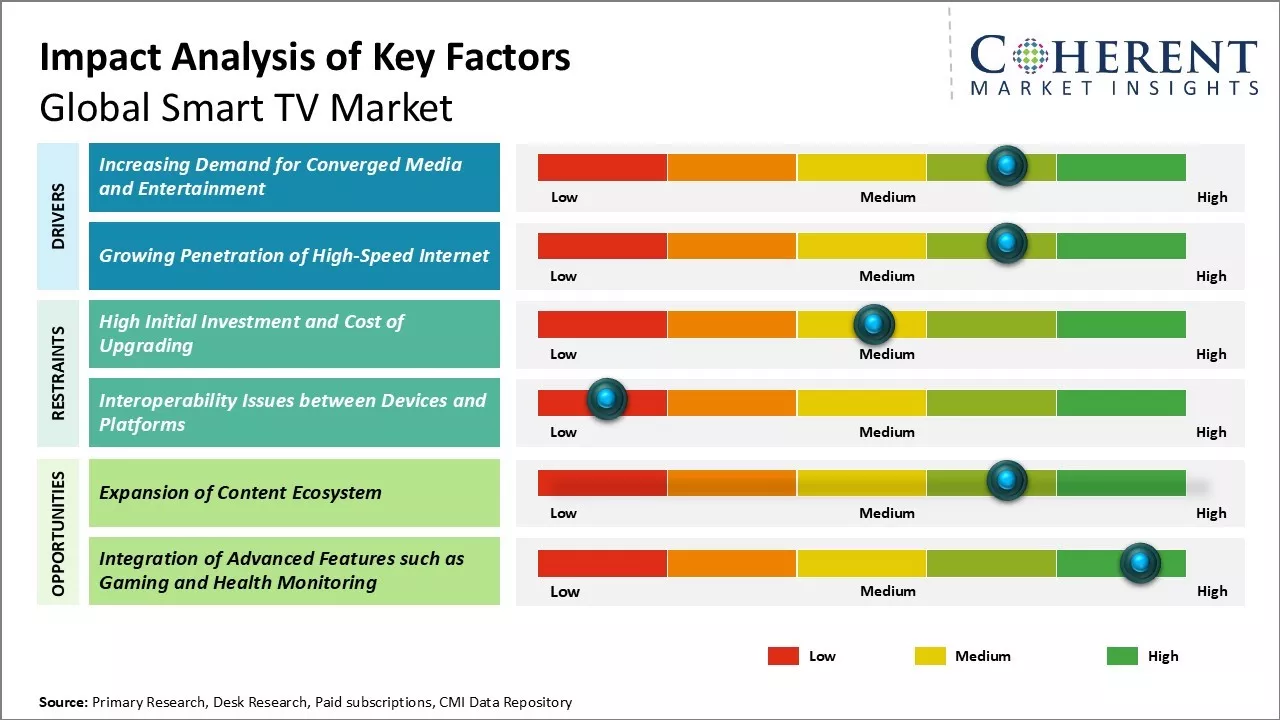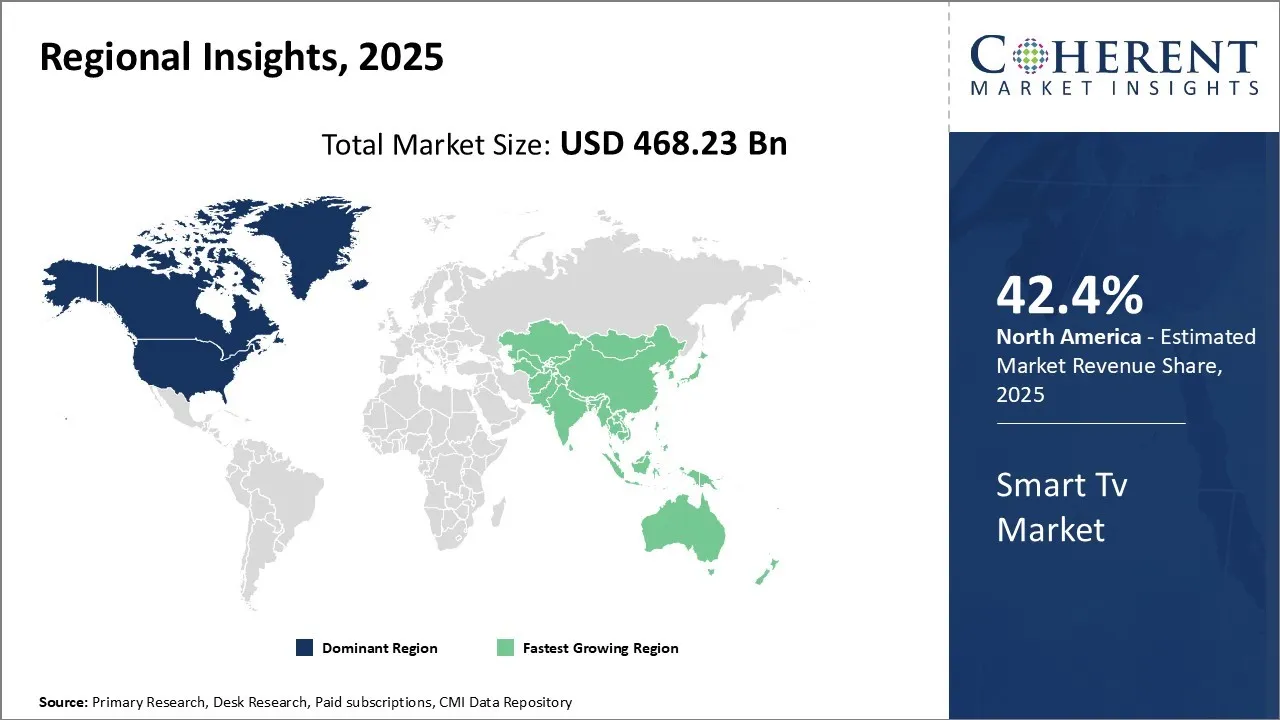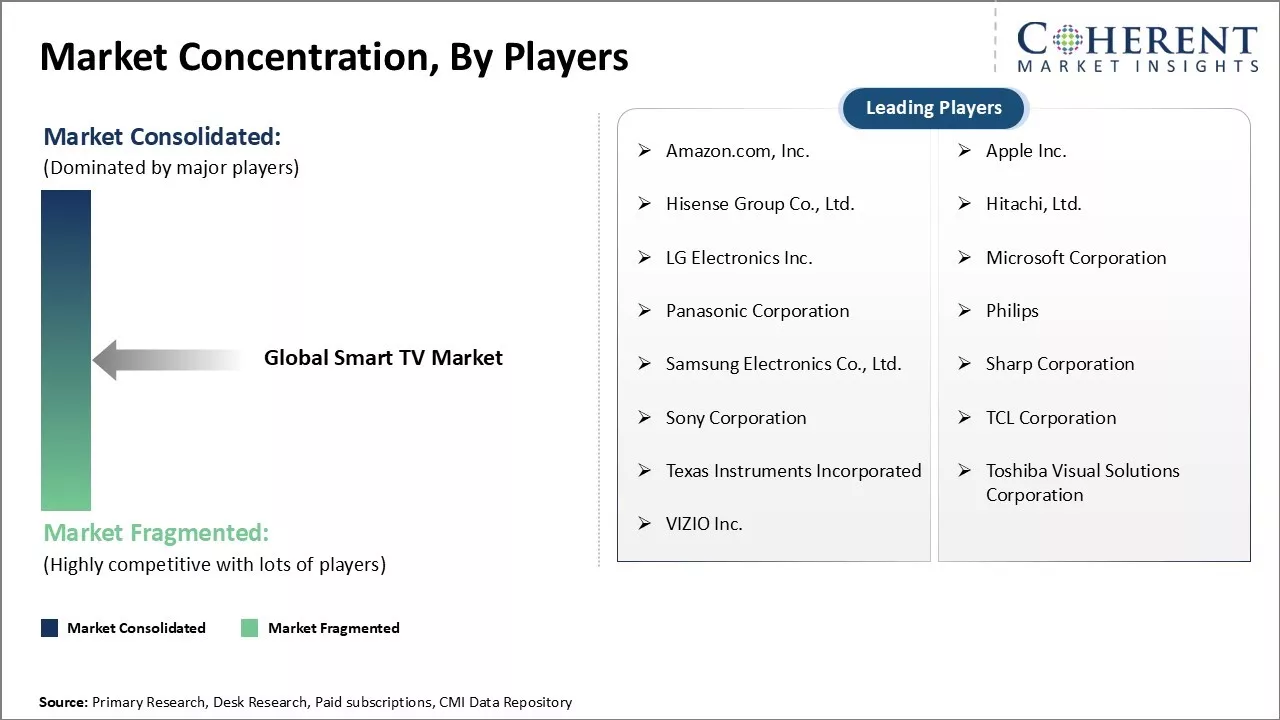Global smart TV market is estimated to be valued at USD 468.23 Bn in 2025 and is expected to reach USD 985.06 Bn by 2032, exhibiting a compound annual growth rate (CAGR) of 11.2% from 2025 to 2032.

To learn more about this report, Download Free Sample
Smart TVs provide advanced features like internet connectivity, access to streaming apps and content, and voice assistants. Rising preference for connected devices and increasing internet penetration can boost demand for smart TVs globally.
|
Current Event |
Description and its Impact |
|
Streaming Wars and Content Platform Evolution |
|
|
5G Network Rollout and Connectivity Infrastructure |
|
Uncover macros and micros vetted on 75+ parameters: Get instant access to report
The smart TV market is experiencing a paradigm shift as artificial intelligence becomes deeply embedded in entertainment technology. AI is no longer just a buzzword but a fundamental driver reshaping how consumers interact with their televisions, making viewing experiences more personalized, intuitive, and engaging than ever before.
For instance, Samsung introduced Vision AI Companion, a platform that brought conversational AI to household televisions. It enabled users to ask questions, receive customized recommendations, and manage tasks using natural voice commands and two-way dialogue.
Evolving entertainment needs and preferences of consumers can drive the smart TV market growth. Traditional television is no longer enough to satiate the appetite of modern audiences who seek an immersive and engaging experience. These people want to access all forms of media through a single screen and smart TVs have emerged as the ideal platform to provide a converged experience.
The proliferation of premium over-the-top (OTT) streaming platforms during pandemic has widened entertainment options. Many people shift to online streaming altogether to cut cord from expensive cable packages. Smart TV emerges as a single gateway to access increasingly popular streaming giants Netflix, Amazon Prime Video, Disney Hotstar and more on large television screens. Seamless content discovery and integrated payment platforms boosts demand for such connected devices.
Ubiquitous high-speed connectivity across regions can drive the smart TV market growth. Fast and reliable internet penetration delivers on the promise of television experience beyond traditional broadcasts. It empowers smart features and unlocks true potential of online content viewing.
Globally, fiber and 5G networks are extending high bandwidth coverage to both urban and remote areas. Majority of developed economies now have access to speeds well above basic requirements for HD video streaming. Even developing regions are making rapid progress towards universal 4G/LTE coverage and rural fiberization.
In terms of screen size, 40 to 50 inches segment is estimated to contribute the highest market share of 34.0% in 2025, owing to its optimal balance of size and affordability. This screen size category appeals to a wide range of consumers thanks to several key advantages.
From a cost perspective, 40 to 50-inch TVs strike a practical sweet spot. Their screens are large enough to deliver an immersive viewing experience but come at mid-range prices that are within financial reach for most households. As affordability is a top priority for budget-conscious buyers, the relatively low prices of these TVs help maximize their appeal.
For instance, German-based audio-video brand Blaupunkt expanded its range of smart TVs in the country with the launch of a 50-inch 4K HDR 10+ TV.
In terms of display technology, LED segment is expected to contribute the highest market share of 47% in 2025 due to its advantages for delivering high-quality images. As screen quality is a leading purchase factor, LED has cemented its status at the forefront of the display technology segment.
Relative to competing technologies, LED televisions provide superior color accuracy, brightness, and black level performance straight out of the box. Their pictures exhibit vibrant, lifelike colors and inky dark scenes without the need for extensive calibration or adjustments.
For instance, in August 2025, Blaupunkt entered the premium smart TV category in India with the launch of its new Google-powered Mini LED televisions.
In terms of operating system, android TV segment is expected to contribute the highest market share of 34.8% in 2025, owing to its extensive app ecosystem. Access to thousands of apps tailored for big-screen enjoyment has made Android OS the system of choice for smart TV fans and cord cutters.
Running Google's popular Android software, Android TV delivers seamless access to the widest selection of apps available for any TV operating system. Viewers can install practically any app these use on mobile, from Netflix and YouTube to games and fitness apps. The immense app library pairs perfectly with large TV screens.
For instance, Global Top-2 TV brand TCL unveiled its P-series 4K HDR TV in India, which came with Android 11.

To learn more about this report, Download Free Sample
North America has established itself as the dominant region in the global smart TV market with an estimated market share of 42.4% in 2025. The U.S. boasts high disposable income of consumers who are early adopters of new technologies. These are constantly switching to the latest TV models featuring enhanced internet and streaming capabilities. This has provided a fillip to smart TV sales.
For instance, in October 2025, FloSports introduced Connected TV app on Samsung and VIZIO smart TVs. Starting that day, the FloSports app became available on Samsung smart TV models from 2018 and later, as well as on all VIZIO Smart TVs. The launch brought more than 50,000 live events and access to more than 25 sports to millions of fans with the simple click of a button. FloSports announced plans to launch on LG smart TVs later in the year, making the sports streamer available on the majority of smart TVs sold in North America.
Asia Pacific region has emerged as the fastest growing market globally led by China and India. Massive manufacturing capabilities of TV brands in these countries coupled with competitive pricing makes smart TVs highly accessible to people. China, with its enormous consumer base, is a lucrative market already accounting for over a third of the APAC market. Government initiatives to improve connectivity in India have bolstered the demand for smart TVs among its youthful population inclined towards OTT media consumption.
For instance, in May 2023, TCL, the world's TOP 2 TV brand and TOP 1 98-inch TV brand, unveiled its latest multi-category products for the Asia Pacific market at an exclusive launch event in Bangkok.
China is likely to hold highest shares in the global smart TV market in 2025. This is owing to the high adoption of advanced home entertainment technologies, strong consumer purchasing power, widespread availability of high-speed internet, and the growing integration of AI-driven features and streaming services in smart TVs.
For instance, in October 2025, Xiaomi expanded its high-end Mini LED TV lineup with the launch of the Xiaomi TV S Pro Mini LED 2026 edition TV in a new 98-inch model in China.
Japan is likely to hold highest shares in the global smart TV market in 2025. This is owing to the strong presence of leading electronics manufacturers such as Sony, Panasonic, and Sharp; continuous advancements in display technologies like OLED and 8K; high consumer demand for premium home entertainment systems; and the country’s rapid adoption of IoT and AI-integrated devices.
For instance, in August 2025, AKAI introduced its new PowerView Series in India, featuring Google TV powered by Android 14. The Japanese consumer electronics brand positioned the lineup as a step forward in home entertainment, combining QLED and 4K displays with advanced gaming features and accessibility-focused options.

To learn more about this report, Download Free Sample
Global smart TV market growth is driven by factors like rising disposable incomes in developing countries, lower prices of smart TVs as compared to previous years, and innovative features offered by brands. Many households, especially young consumers, prefer smart TVs due to its connectivity features and content options. North America is likely to dominate the global market in 2025, owing to high disposable income of early adopters of new technologies.
| Report Coverage | Details | ||
|---|---|---|---|
| Base Year: | 2024 | Market Size in 2025: | USD 468.23 Bn |
| Historical Data for: | 2020 To 2024 | Forecast Period: | 2025 To 2032 |
| Forecast Period 2025 to 2032 CAGR: | 11.2% | 2032 Value Projection: | USD 985.06 Bn |
| Geographies covered: |
|
||
| Segments covered: |
|
||
| Companies covered: |
Amazon.com, Inc., Apple Inc., Hisense Group Co., Ltd., Hitachi, Ltd., LG Electronics Inc., Microsoft Corporation, Panasonic Corporation, Philips, Samsung Electronics Co., Ltd., Sharp Corporation, Sony Corporation, TCL Corporation, Texas Instruments Incorporated, Toshiba Visual Solutions Corporation, and VIZIO Inc. |
||
| Growth Drivers: |
|
||
| Restraints & Challenges: |
|
||
Uncover macros and micros vetted on 75+ parameters: Get instant access to report
Expansion of the content ecosystem available for viewers can offer market growth opportunities. As broadband and cellular connectivity expands across the world, there is a growing market for over-the-top media services delivering video and audio content. Major players like Netflix, Amazon Prime Video, YouTube and many regional providers have started offering their vast libraries of TV shows, movies, news and podcasts that can be seamlessly played on smart TVs.
*Definition: Global smart TV market consists of manufacturers, distributors, and retailers involved in the production, distribution, and sales of internet-connected televisions with integrated apps and services. Smart TVs allow users to access over-the-top content from various streaming services, browse the internet, download third-party applications, and control smart home devices through voice commands.
Share
Share
About Author
As an accomplished Senior Consultant with 7+ years of experience, Pooja Tayade has a proven track record in devising and implementing data and strategy consulting across various industries. She specializes in market research, competitive analysis, primary insights, and market estimation. She excels in strategic advisory, delivering data-driven insights to help clients navigate market complexities, optimize entry strategies, and achieve sustainable growth.
Missing comfort of reading report in your local language? Find your preferred language :
Transform your Strategy with Exclusive Trending Reports :
Frequently Asked Questions
Joining thousands of companies around the world committed to making the Excellent Business Solutions.
View All Our Clients